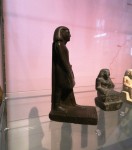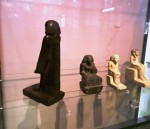 Back in February of this year, Manchester Museum‘s Egyptian artifacts curator Campbell Price was walking by a display case of Middle Kingdom funerary statuettes when he noticed one of the figurines was facing the back. Very few people have the keys to the display case and if any one of them had turned the 3,800-year-old statue around for a reason, like to expose the prayer inscribed on the back, they would have checked with him first. He put it back facing forward, but the next time he noticed the statuette was turned at a different angle. The day after it was at a third angle.
Back in February of this year, Manchester Museum‘s Egyptian artifacts curator Campbell Price was walking by a display case of Middle Kingdom funerary statuettes when he noticed one of the figurines was facing the back. Very few people have the keys to the display case and if any one of them had turned the 3,800-year-old statue around for a reason, like to expose the prayer inscribed on the back, they would have checked with him first. He put it back facing forward, but the next time he noticed the statuette was turned at a different angle. The day after it was at a third angle.
None of the other figurines in the display case had budged. Price was mystified. He asked other museum staffers about it and nobody knew anything about it. Enter the inevitable speculation about eerie ancient Egyptian curses/mystical powers/pyramid energies. These kinds of statuettes were placed in the tomb as a representation of the deceased. Mourners would leave offerings at its feet, as referenced in the inscription on the back:
on the back:
“An offering which the king gives to Osiris, Lord of Life, that he may give a voice offering, consisting of bread, beer, oxen and fowl for the Ka-spirit of”
The sentence is finished with an inscription of the deceased’s name on the front of the statuette base. It’s hard to read in this case, but the name appears to be “Neb-Senu.” According to Price, the Egyptians believed that these statuettes could act back-up vehicles for the spirit of the departed in the afterlife should the mummy be destroyed. Perhaps the soul of Neb-Senu felt like pirouetting.
The mummy and the statuette have been separate since at least 1933 when it was donated to the museum by Annie Barlow, daughter of Bolton cotton mill magnate James Barlow. The mill imported a great deal of cotton from Egypt and Annie became fascinated with Egyptian archaeology. She was a prominent supporter of the Egypt Exploration Society (EES) and personally traveled to its excavation on the Nile Delta in 1888. This was a bold choice for a single 25-year-old woman at the time. She was also a generous donor to local museums. Under the partage system, archaeological teams were entitled to keep a percentage of any artifacts they found. Annie Barlow consistently gifted her share of EES loot to museums like the Chadwick Museum (now the Bolton Museum) and the Manchester Museum.
Even as they indulge in a little fun with the allure of an exotic Egyptian religious source for the turning, the curators are well aware that there is most likely a simple physical explanation. Vibration from visitors walking by the case or from traffic outside could cause the movement, but it’s still odd that the statue has never moved before and that none of the other statuettes in the case move an inch.
To solve the mystery of the spinning statuette, the Manchester Museum staff set up a time-lapse camera to take one picture a minute for a week. This is the extremely awesome result.
[youtube=http://youtu.be/S0fbWm9tdHE&w=430]
Nobody is punking the museum. Neb-Senu is definitely moving on his own. Eat your heart out, Night at the Museum (that movie was such a disappointment).
Particle physicist and TV host Brian Cox weighed in on the issue. Not surprisingly, he does not attribute the statuette’s dance to ancient Egyptian spirits, but rather to differential friction. Curator Campbell Price is still mystified.
“Brian thinks it’s differential friction where two surfaces, the serpentine stone of the statuette and glass shelf it is on, cause a subtle vibration which is making the statuette turn. But it has been on those surfaces since we have had it and it has never moved before. And why would it go around in a perfect circle?”
 I asked an extremely smart scientician type I know for clarification and he explained that it’s not just the two surfaces — stone and glass — which have different friction coefficients, but different parts of the statue’s base. You can clearly see in pictures that the base is uneven. There are lumps and bumps, missing bits, smoother parts, rougher parts. That means some parts of the base are going to experience more friction against the glass shelf than others. If one corner is rougher, then when the vibrations from the floor or the outside put lateral stress on the shelf, that rougher corner with the highest friction
I asked an extremely smart scientician type I know for clarification and he explained that it’s not just the two surfaces — stone and glass — which have different friction coefficients, but different parts of the statue’s base. You can clearly see in pictures that the base is uneven. There are lumps and bumps, missing bits, smoother parts, rougher parts. That means some parts of the base are going to experience more friction against the glass shelf than others. If one corner is rougher, then when the vibrations from the floor or the outside put lateral stress on the shelf, that rougher corner with the highest friction will stay put while the rest of the base rotates around it.
will stay put while the rest of the base rotates around it.
That doesn’t explain why it would start in February all of a sudden, but the statuette and its shelf are in the museum’s new Egyptian Afterlife gallery and even a small change in the circumstances — a cleaning or polishing of the statue, increased vibrations from, say, construction work — could have caused the not-all-that-wild rumpus to begin.